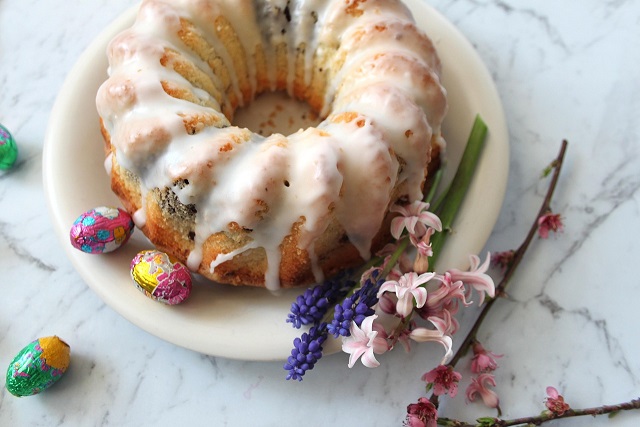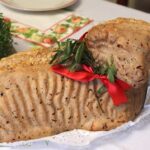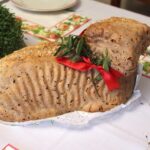
Easter in Germany is a time of joy, tradition, and delicious baked goods, and Osterkranz is one of the most festive treats. This soft, braided yeast bread, shaped into a circular wreath, is often decorated with colorful dyed eggs, making it a beautiful centerpiece for Easter brunch. The slightly sweet, buttery dough has a light, fluffy texture, and some variations include raisins, citrus zest, or almonds for added flavor.
The wreath shape of Osterkranz is symbolic, representing eternity and renewal, while the eggs nestled within the braid signify new life and rebirth. This bread has been a part of German Easter celebrations for generations, and now you can learn to bake it at home. Follow this easy, step-by-step Osterkranz recipe, and bring a taste of German Easter traditions to your table.
History & Cultural Significance
The Origins of Osterkranz
Braided breads have been a staple of German baking for centuries, and Osterkranz, meaning “Easter wreath”, is a festive variation of Osterzopf. This beautifully woven bread became popular in southern Germany and Austria, where Easter traditions often incorporate symbolic foods. The wreath shape represents the continuity of life, while the eggs—often baked directly into the braid—are associated with fertility and renewal.
Osterkranz is traditionally baked on Easter Sunday morning and enjoyed for breakfast or brunch, served with butter, honey, or jam. In some regions, families prepare a savory version, omitting the sugar and topping it with sesame or poppy seeds.
Across Germany, variations of Osterkranz exist. Some recipes use cardamom and lemon zest for a fragrant aroma, while others incorporate dried fruit and almonds. No matter how it’s made, Osterkranz remains a cherished Easter tradition.
Want to explore more German Easter recipes? Check out our articles on German Easter Traditions and How Germany Became the Land of Bread.
Ingredients & Preparation (Step-by-Step Recipe Guide)
Ingredients for Authentic Osterkranz
Dough Ingredients:
- 500g (4 cups) all-purpose flour
- 75g (⅓ cup) sugar
- 1 packet (7g) dry yeast or 25g fresh yeast
- 250ml (1 cup) warm milk
- 80g (⅓ cup) unsalted butter, softened
- 1 egg
- 1 tsp salt
- ½ tsp vanilla extract (optional)
- Zest of 1 lemon (optional)
- 50g (⅓ cup) raisins (optional)
For Brushing & Topping:
- 1 egg yolk, beaten (for glazing)
- 2 tbsp milk
- 3-4 dyed Easter eggs (optional, for decoration)
- 2 tbsp sliced almonds or pearl sugar
Substitutes: If you don’t have fresh yeast, use dry yeast (7g = one packet). For added aroma, try adding a pinch of cardamom or a teaspoon of orange zest.
How to Make Osterkranz (Step-by-Step Instructions)
Step 1: Activate the Yeast
- Warm the milk slightly (not too hot).
- Stir in sugar and yeast, let it sit for 5-10 minutes until frothy.
Step 2: Prepare the Dough
- In a large mixing bowl, combine flour, salt, and lemon zest.
- Add the yeast mixture, butter, egg, vanilla extract, and raisins (if using).
- Knead the dough for 10 minutes until smooth and elastic.
Pro Tip: If the dough is sticky, sprinkle in a bit more flour. If it’s dry, add a spoonful of warm milk.
Step 3: Let the Dough Rise
- Cover the dough with a clean towel and let it rise in a warm place for 60-90 minutes until doubled in size.
Step 4: Shape & Braid the Osterkranz
- Divide the dough into three equal pieces and roll them into long strands.
- Braid the strands together, then form a circle and pinch the ends together to create a wreath shape.
- Place the braided wreath on a baking sheet lined with parchment paper.
Step 5: Final Rise & Baking
- Cover and let the dough rise again for 30 minutes.
- Preheat oven to 180°C (350°F).
- Brush the braid with egg yolk mixed with milk and sprinkle with almonds or sugar.
- Carefully place dyed Easter eggs between the braids (if using).
- Bake for 25-30 minutes, or until golden brown.
Serving Suggestions & Variations
How to Serve Osterkranz
Osterkranz is best served fresh and slightly warm with:
- Butter and honey for a traditional German Easter breakfast
- Homemade jam or Nutella for a sweeter option
- Soft cheese or quark for a creamy contrast
Variations & Regional Twists
In Bavaria, Osterkranz often includes raisins soaked in rum for extra flavor. In Swabia, it is sometimes made without sugar and served as a savory bread. In Austria, a hint of cardamom and dried fruit is added for a fragrant, festive touch.
Want to try another Easter treat? Check out our Osterlamm (Easter Lamb Cake) recipe.
Baking Osterkranz at home is a wonderful way to celebrate Easter with a delicious and symbolic treat. Its soft, fluffy texture and festive appearance make it a highlight of any Easter brunch. Whether you enjoy it plain, with butter, or decorated with colorful eggs, Osterkranz brings a touch of German tradition to your table.
Looking for more traditional German Easter recipes? Explore our recipes for Osterzopf, Rüblikuchen, and Hefezopf.







